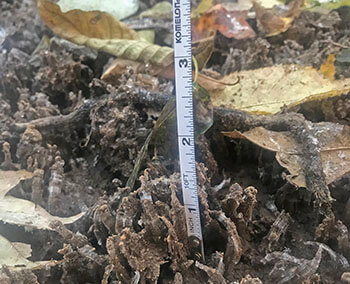Frost Seeding Clover — Ask Our Experts
Jan 27, 2020

By Brett Jones, Tennessee Farmers Cooperative regional agronomy specialist, and
Greg Aston, Allied Seed South Central sales representative
HOW FROST SEEDING WORKS
The broadcasted seed is gradually buried in the soil as the ground expands and contracts from early morning freezes and afternoon thaws. This method does not disturb the existing sod, so it is good for erodible areas. Access to the area for grazing is quicker than conventionally tilled seedbeds, and it’s economical, requiring no expensive equipment, just seed and labor.
7 TIPS TO FROST SEEDING CLOVER SUCCESS
Q & A WITH BRETT AND GREG
QUESTION: Why can’t farmers just plant clover and grass together in the fall?
ANSWER: Sowing both seed types at once creates two major problems:
ANSWER: Frost seeding the clover in February.
ANSWER: There’s a positive relationship between the grass and the legumes like clover.
ANSWER: Of course, we want you to purchase our seed (SEE TIPS FOR OUR RECOMMENDATIONS); however, our main goal is to help the grower to be successful.
ANSWER: Ideally, two years. In order to have a clean pasture with the right percentage of legumes in it, you should:
ANSWER: It depends. This is something that we have to have boots on the ground so to speak to look at what’s actually there and be able to truly evaluate on a field-by-field basis.
Need more information or advice about frost seeding clover in February? Contact your local Co-op or email your TFC regional agronomist: East/Tom Bible at tbible@ourcoop.com; Middle/Brett Jones at bjones@ourcoop.com; Cumberland Plataeau/Cole Delong at cdelong@ourcoop.com; West/Trevor Smith at tsmith@ourcoop.com.
Greg Aston, Allied Seed South Central sales representative
HOW FROST SEEDING WORKS
The broadcasted seed is gradually buried in the soil as the ground expands and contracts from early morning freezes and afternoon thaws. This method does not disturb the existing sod, so it is good for erodible areas. Access to the area for grazing is quicker than conventionally tilled seedbeds, and it’s economical, requiring no expensive equipment, just seed and labor.
7 TIPS TO FROST SEEDING CLOVER SUCCESS
- Perform soil test.
- Begin frost seeding clover in February — mid-month is ideal — for best results. The freezes are minimal when clover gets established. If you miss this window, a chain harrow in March will work.
- Cattle can remain on field during and after seeding. When clover is 3-4 inches tall, remove cattle and wait to reintroduce them after stand is established.
- Choose white clover for its persistence for grazing and a mixture of red and white clover for hay and pastures.
- Choose these improved seed varieties — Will Ladino white clover and FSG 401RC red clover, both available pre-coated and inoculated.
- Pasture should include 25-30 percent clover for maximum production results. To achieve that percentage, frost seed 1-2 pounds of white clover and 4-6 pounds of red clover per acre.
- Selective herbicides can be applied to an established stand of clover to reduce broadleaf weeds.
Q & A WITH BRETT AND GREG
QUESTION: Why can’t farmers just plant clover and grass together in the fall?
ANSWER: Sowing both seed types at once creates two major problems:
- The tiny clover is buried too deep in the ground when drilled in with the grass.
- There are currently no labeled chemicals that can clean up weeds without killing the clover seedlings.
ANSWER: Frost seeding the clover in February.
- The heaving and retracting of the ground gradually plant the seed at a shallow depth.
- Waiting to plant the clover allows for time to clean up weeds once grass is established.
ANSWER: There’s a positive relationship between the grass and the legumes like clover.
- The clover produces nitrogen that provides ongoing nutrients for the grasses.
- Animal performance increases with a mix; compared to just grass, the grass/clover mix increases forage quality and provides improved digestibility, increased protein, and less endophyte issues than with fescue.
ANSWER: Of course, we want you to purchase our seed (SEE TIPS FOR OUR RECOMMENDATIONS); however, our main goal is to help the grower to be successful.
- That means field management must come first.
- I don’t want you putting clover seed out that costs X dollars on a field that’s full of sage grass and terribly nutrient deficient.
- I want it to be in a good environment so the seed can be successful.
ANSWER: Ideally, two years. In order to have a clean pasture with the right percentage of legumes in it, you should:
- Do a fall seeding of grasses,
- Get the weeds contained during the spring and summer,
- And then frost seed clover the following winter.
ANSWER: It depends. This is something that we have to have boots on the ground so to speak to look at what’s actually there and be able to truly evaluate on a field-by-field basis.
- As farmers, we often fall into the trap of doing all or none
- We say, “I’m either going to spray my entire farm or none of it,” or “I’m either going to put clover on all of it, or I’m not going to put it out at all.”
- We need to break out of that mindset. We need to say, “This is the field that needs the most attention; let’s address it first instead of doing it all.”
- By taking that approach, we’re able to manage for peak growth through rotation and progression.
Need more information or advice about frost seeding clover in February? Contact your local Co-op or email your TFC regional agronomist: East/Tom Bible at tbible@ourcoop.com; Middle/Brett Jones at bjones@ourcoop.com; Cumberland Plataeau/Cole Delong at cdelong@ourcoop.com; West/Trevor Smith at tsmith@ourcoop.com.